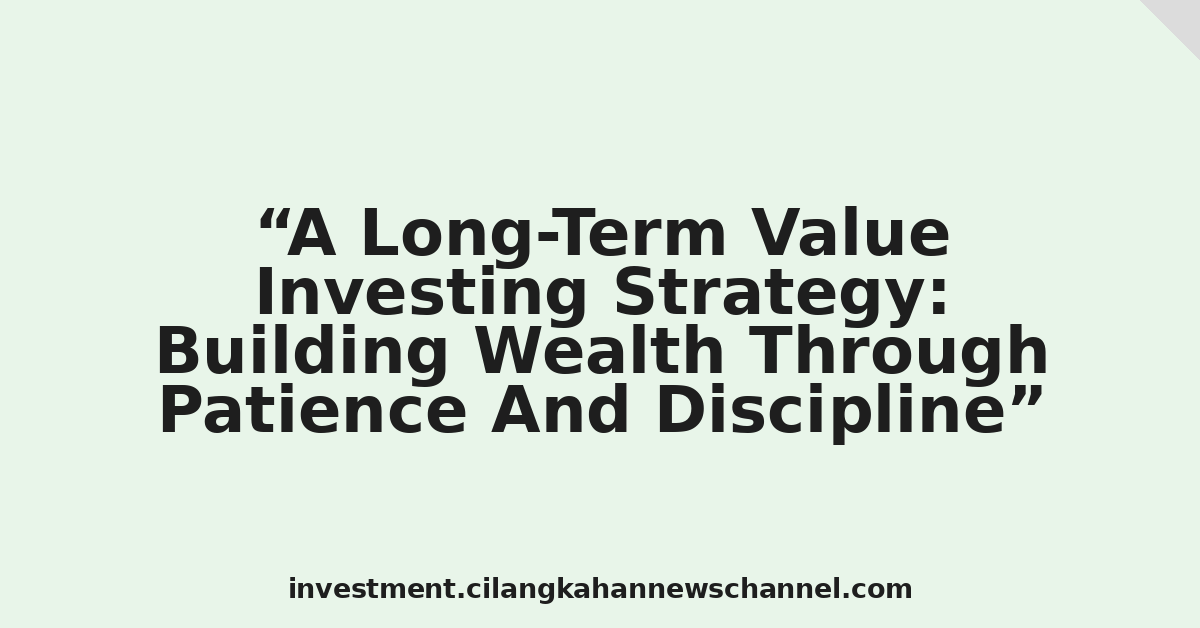The allure of quick riches in the stock market is undeniable. The promise of overnight gains, fueled by social media hype and speculative trading, often overshadows the proven, albeit slower, path to wealth creation: long-term value investing. This strategy, championed by legendary investors like Warren Buffett, focuses on identifying undervalued companies with strong fundamentals and holding them for the long haul, allowing their intrinsic value to appreciate over time. While it requires patience, discipline, and a deep understanding of financial statements, the rewards can be substantial and significantly outperform market averages in the long run.
Hello readers of investment.cilangkahannewschannel.com. This article delves into the core principles of a successful long-term value investing strategy, outlining the key steps involved, the potential pitfalls to avoid, and the mindset necessary for sustained success. We’ll explore how to identify undervalued companies, conduct thorough due diligence, manage risk effectively, and maintain the emotional fortitude required to weather market volatility.
1. Understanding Intrinsic Value:
The cornerstone of value investing is identifying the intrinsic value of a company – its true worth independent of its current market price. This involves a thorough analysis of the company’s financial statements, including the income statement, balance sheet, and cash flow statement. Key metrics to consider include:
- Revenue Growth: Consistent and sustainable revenue growth indicates a healthy and expanding business. Look for companies with a history of increasing revenue and a clear path to future growth.
- Profitability: Analyze profit margins (gross, operating, and net) to assess the company’s ability to generate profits from its operations. High and stable profit margins suggest efficient operations and pricing power.
- Return on Equity (ROE): This metric measures how effectively a company uses shareholder equity to generate profits. A high and consistent ROE indicates efficient capital allocation.
- Debt Levels: Excessive debt can cripple a company’s financial health. Analyze the company’s debt-to-equity ratio and interest coverage ratio to assess its financial leverage and ability to service its debt.
- Cash Flow: Focus on free cash flow (FCF), which represents the cash a company generates after accounting for capital expenditures. Strong and consistent FCF is crucial for dividend payments, debt reduction, and reinvestment in the business.
Beyond these quantitative metrics, qualitative factors are equally important. These include:
- Competitive Advantage (Moat): Look for companies with a sustainable competitive advantage, such as strong brands, patents, economies of scale, or unique business models. This advantage protects them from competition and ensures long-term profitability.
- Management Quality: Assess the competence and integrity of the company’s management team. A strong management team is crucial for effective execution of the company’s strategy and long-term success.
- Industry Trends: Understand the industry in which the company operates and its future prospects. Investing in companies in declining industries can be risky, even if they are undervalued.
2. Conducting Thorough Due Diligence:
Identifying potentially undervalued companies is just the first step. Thorough due diligence is crucial to validate your findings and mitigate risk. This involves:
- Reading Annual Reports and 10-K Filings: These documents provide a wealth of information about the company’s financial performance, business operations, and risk factors.
- Analyzing Industry Reports and Analyst Estimates: Gain a broader perspective on the industry and the company’s competitive landscape.
- Following News and Developments: Stay informed about relevant news and developments that could impact the company’s performance.
- Seeking Independent Opinions: Discuss your investment thesis with other investors or financial professionals to gain different perspectives.
3. Building a Diversified Portfolio:
While focusing on individual companies, diversification is crucial to mitigate risk. Don’t put all your eggs in one basket. Spread your investments across different sectors and industries to reduce the impact of any single company’s underperformance. A well-diversified portfolio can help smooth out returns and reduce overall volatility.
4. Maintaining Patience and Discipline:
Long-term value investing requires patience and discipline. Market fluctuations are inevitable, and there will be times when your investments underperform. It’s crucial to stick to your investment strategy and avoid making impulsive decisions based on short-term market movements. Emotional discipline is key to long-term success. Avoid being swayed by market noise or fear-based selling.
5. Regularly Reviewing and Rebalancing Your Portfolio:
Regularly review your portfolio to ensure it aligns with your investment goals and risk tolerance. Rebalance your portfolio periodically to maintain your desired asset allocation. This involves selling some of your winners and buying some of your losers to restore your target asset allocation.
6. Avoiding Common Pitfalls:
Several common pitfalls can derail a long-term value investing strategy. These include:
- Chasing Short-Term Gains: Focus on long-term value creation, not short-term price fluctuations.
- Ignoring Risk: Thoroughly assess the risks associated with each investment before committing your capital.
- Overconfidence: Don’t let past successes cloud your judgment. Remain humble and continuously learn from your mistakes.
- Emotional Decision-Making: Avoid making investment decisions based on fear or greed.
- Lack of Patience: Value investing requires patience. Don’t expect overnight riches.
7. Adapting to Changing Market Conditions:
The market is constantly evolving. It’s important to adapt your investment strategy to changing market conditions. This might involve adjusting your asset allocation, diversifying into new sectors, or reassessing your investment thesis for existing holdings.
8. Continuous Learning and Improvement:
The world of finance is constantly evolving. Stay updated on market trends, economic indicators, and new investment strategies. Continuous learning is crucial for long-term success in value investing.
In conclusion, a successful long-term value investing strategy requires a combination of thorough research, disciplined execution, and emotional fortitude. By focusing on identifying undervalued companies with strong fundamentals, conducting thorough due diligence, and maintaining patience, investors can significantly increase their chances of building substantial wealth over the long term. Remember, it’s a marathon, not a sprint. The journey may be challenging, but the rewards for those who persevere are well worth the effort. Consistent application of these principles, coupled with continuous learning and adaptation, will pave the way for long-term financial success.

